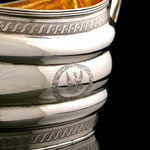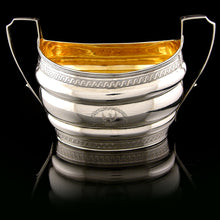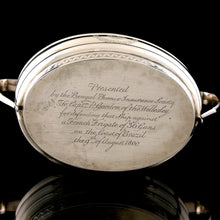A French Revolutionary Wars Naval Engagement Presentation Bowl, 1801
Adding product to your cart
Width 19.5cm (7.5ins)
A two handled sugar bowl of ovoid baluster form with gilt interior, engraved with flowing scrollwork border decoration, and, to each side, a phoenix rising from the flames within an oak leaf wreath. The base additionally inscribed, ‘Presented by the Bengal Phoenix Insurance Society to Capt. P. Gordon of the Wellesley for defending that ship against a French Frigate of 36 Guns on the coast of Brazil, the 9th of August 1800’. Hallmarked, London 1801.
Read more
In the summer of 1800 the Wellesley was part of a convoy of East Indiamen carrying Government stores from Britain to India under the protection of a 64-gun escort H.M.S. Belliqueux (Captain Rowley Bulteel R.N.), when it was sighted by a French commerce raiding force under Commodore Jean-François Landolphe. The French force of three frigates had eluded the British blockade of Rochefort the previous year and raided down the west coast of Africa causing serious disruption to trade, before being obliged to refit in the allied Spanish shipyards of the River Plate. On leaving the Plate, the Concorde (Landolphe), Médée (Captain Jean-Daniel Coudin) and Franchise (Captain Pierre Roch Jurien de La Gravière) captured an American schooner, which they fitted out as a tender, and sighted the Wellesley and the rest of the British convoy off the Brazilian coast.
Uncertain as to the identity of the ships, the French squadron gradually closed until Landolphe could see that there were seven large vessels and three smaller ones, all unmistakably British. At noon on 4 August he sighted double rows of gunports as Rowley Bulteel ordered the larger East Indiamen into line of battle in order to give the impression of a powerful naval force. Landolphe immediately responded by calling off his attack and signalled his ships to split up despite the protestations of Captain Jurien of the Franchise who continued to insist the British ships were merchantmen.
Maintaining the bluff, Rowley Bulteel then ordered a pursuit of Médée and Franchise by East Indiamen Exeter, Bombay Castle, Coutts and Neptune while his H.M.S. Belliqueux engaged Concorde. At length Belliqueux took Concorde while Exeter pulled off an extraordinary feat in capturing Médée, overhauling her at night and intimidating her into surrendering by arranging lights behind every gunport, whether or not it contained a cannon.
Thus only Franchise made good her escape, but only by dumping lifeboats, guns and supplies overboard. No doubt seething at his misfortune, it is recorded that Captain Jurien and the Franchise remained in Brazilian waters for next three weeks but, it is said, without sighting sail. Contrary to the histories, however, the inscription on the present bowl indicates this was not the case. Given the fates of Concorde and Médée, Jurien was no doubt anxious to avoid direct contact with Belliqueux or the larger East Indiamen each armed with 30 guns apiece and capable carrying cargoes of 1200 tonnes, but nevertheless anxious for a worthy prize somehow he singled out and engaged the Wellesley on 9 August as the convoy headed to Rio de Janeiro (reached on the 12th and thence to St Helena and finally to India). Unfortunately for Jurien, then, it was Captain Gordon who emerged with the credit, beating off the French attack and leaving Franchise to return to France empty handed.
The honour won on 9 August 1800 was long upheld by Captain Gordon’s family. In 1804 when his second daughter married a barrister in Islington the marriage notice referred to her as the offspring of ‘Captain Gordon of the Wellesley’. Likewise the Captain’s son and namesake Peter Gordon referred to his father’s service in petitioning the House of Lords in 1841, stating, he ‘served the Govt. for a time as Commodore of the expedition to Egypt; [and] afterwards fell in with a French frigate, La Franchise, off the coast of Brazil and beat her off, the Wellesley then being laden with Govt. stores for the Cape [sic];’ additionally informing their Lordships, ‘he got a piece of plate for this service’.
Four other items of silver presented to Captain Gordon by the Bengal Phoenix Insurance Company surfaced in the 1960s. These were a large tray with, and a pair of candlesticks, both engraved with the Bengal Phoenix company’s insignia and an identical inscription, as well as a pair of salts engraved with the insurers’ initials ‘B.P.I.S.’ (see Country Life, 1966, vol. 140, p.371).
Captain Peter Gordon (b. Speymouth, 1743, d. Islington, 1806) was the younger son of James Gordon (1696-1765), a merchant of Garmouth, Moray, Scotland, and nephew of Alexander Gordon, Writer to the Signet and 7th Laird of Cairnfield. As an officer of the Honourable East India Company's merchant service, he was appointed Commodore of the transports that conveyed the Company's troops under Sir David Baird to Kosseir, Egypt, to assist Sir Ralph Abercrombie in the expulsion of Bonaparte 's expedition. Gordon made numerous long voyages in the Wellesley between Britain, India and China, conveying personnel, stores and trade goods outbound, rich cargoes from the east inbound. He married Ann Phillips, daughter of the Sheriff of St. Johns, Newfoundland, and had two sons and four daughters, including Peter (1790-1857), captain in the mercantile marine, who had a remarkable career as an explorer, missionary, and writer. In 1804 the 1797-Calcutta-built Wellesley was sold to the Royal Navy and refitted at Rotherhithe as a fifth rate 44-gun ship of the line, H.M.S. Weymouth. She was broken up in 1865. Gordon's adversary of 9 August 1800, Jurien, survived the Revolutionary and Napoleonic wars to become an Admiral and to die in Paris in 1849.
References:
Asiatic Annual Register, 1804
Oriental Herald and Colonial Review, 1824
Country Life, 1966, Vol.140, p. 371
‘Gordons of Cairnfield and Rosieburn’, Dr J.M. Bulloch, Leith, 1910
‘The Gay Gordons’, Dr. J.M. Bulloch. Chapman & Hall, 1907
Aberdeen Journal, 4 January 1938








